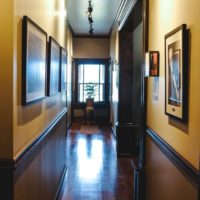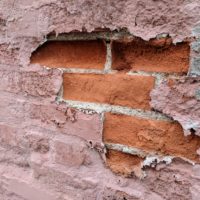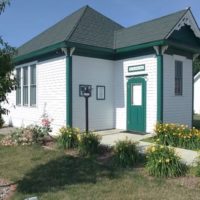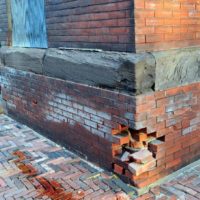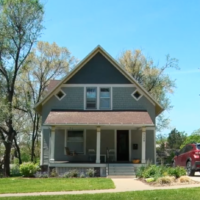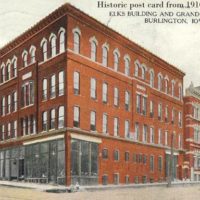timeline mural that will mark the location of the Des Moines’s first settlement
Posted by mw on May 26th, 2010 11:22 am
Bill Sherman was standing alongside the log cabin that sits on a small mound of grass outside Principal Park on Tuesday when another idea hit him.
He and the two people with him, Belgian-born artist Hilde DeBruyne and Jim Belilove, the owner of a Fairfield tile plant, were having their picture taken to promote an art project sponsored by the Polk County Historical Society, of which Sherman is president.
The project is a timeline mural created by DeBruyne that will mark the location of the Des Moines area’s first white settlement in 1843.
Later this summer, DeBruyne’s mural will be transferred to mosaic tiles by Creative Edge, Belilove’s tile and stone-cutting company.
Computer technology will organize the more than 5,000 pieces of tile into a mosaic reproduction of the mural, which depicts American Indian life, the first white settler, various symbols and the future.
Sometime after the baseball season ends in September, the 32-foot long mural will be reassembled on a brick wall near the log cabin.
Sherman, who retired 10 years ago as public relations director for the Iowa State Education Association, has been head of the local historical society for the past three years. As such, he’s faced the same problem that others have: How to tell the story of a community’s founding in a compelling and lasting way.
Modern efforts to tell the story of Des Moines’ founding began in the 1960s, when a log cabin was found in Washington County that was supposedly built in the 1840s.
In 1964, the cabin was moved to a site on the west bank of the Des Moines River, north of its confluence with the Raccoon River.
The area is near where Capt. James Allen and 50 other soldiers pulled ashore on May 20, 1843, to begin building a fort. It wasn’t much of a military outpost, in that it was intended mainly to deter white settlers from entering the region, Sherman said. Fort Des Moines was mostly a collection of log buildings, most of which were replaced soon after the city of Des Moines was established in 1846.
The log cabin wasn’t much of a landmark, but it served as a placeholder while other development occurred around it.
During those years, Sherman’s interest in history was growing. While he was with the ISEA, he became interested in one-room schools.
In fact, he was the guy eight years ago who successfully promoted Grant Wood’s painting of a one-room school as the image that now appears on the Iowa quarter.
If there was a compelling way to tell the story of Des Moines’ founding, Sherman would find it.
The Polk County Historical Society has a budget for the project of $34,000, although it’s still a few thousand dollars short.
With little money to spend, Sherman knew he needed an emerging artist whose fee would be low.
He found DeBruyne, a sculptor in Cumming who had moved to Iowa 12 years ago with her husband, cardiac surgeon Dr. Marnix Verhofste.
He also found Creative Edge, Belilove’s company in Fairfield, which has done work for commercial and residential clients around the world, but which had not done much work in central Iowa. Exposure here would be good for business.
In addition to the historical society project, Belilove said, Creative Edge will create a giant mural for the new Jacobson Building at the Iowa State Fair this year. It will feature quilt designs from every county in Iowa.
Tuesday morning, as Belilove, Sherman and DeBruyne toured the founders’ site, Belilove explained how ceramic tiles produced by Creative Edge hold their color and won’t fade, even when exposed to weather.
The founders’ mural will last a long time, he said.
DeBruyne agreed and said that, once the mural is in place, the only thing left will be to landscape the area between it and the log cabin.
Two blocks away, Sherman could see school buses unloading at the Science Center of Iowa.
That’s when he got the idea.
Once the mural is in place, he said, the school children who make field trips to the Science Center will be able to walk a little farther and take in a piece of Des Moines’ history.
“Science there, history here,” he said, pointing to the place in the wall where DeBruyne’s mural will go.
To find out more, go to: http://www.desmoinesregister.com/
Comments
Pat Meiners commented on May 27th, 2010 at 7:40 pm:
The Polk County Historical Society disbanded in December of 2006. Ask Bill when he was elected and to see any current meeting minutes or the list of dues paying members. He won’t be able to because they don’t exist. The PCHS board was to distribute remaining funds to currently existing historical organizations within Polk County and report to the members in 2007, but he chose to make his own plans.
This is not a PCHS project! It is barely decorative, not at all informative and possibly derogatory to Native Americans. It creates more questions than it answers. It may qualify as ‘art,’ but it is not history.
Pat Meiners, President, Des Moines Historical Society (126 DUES PAYING members)

